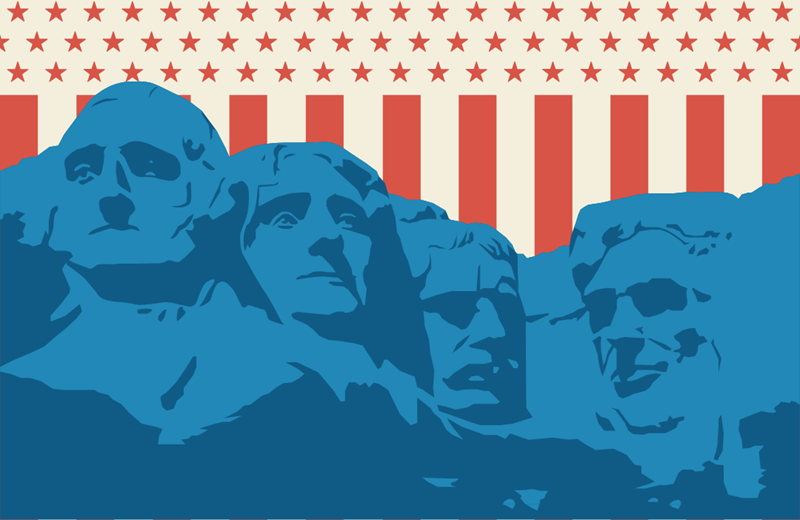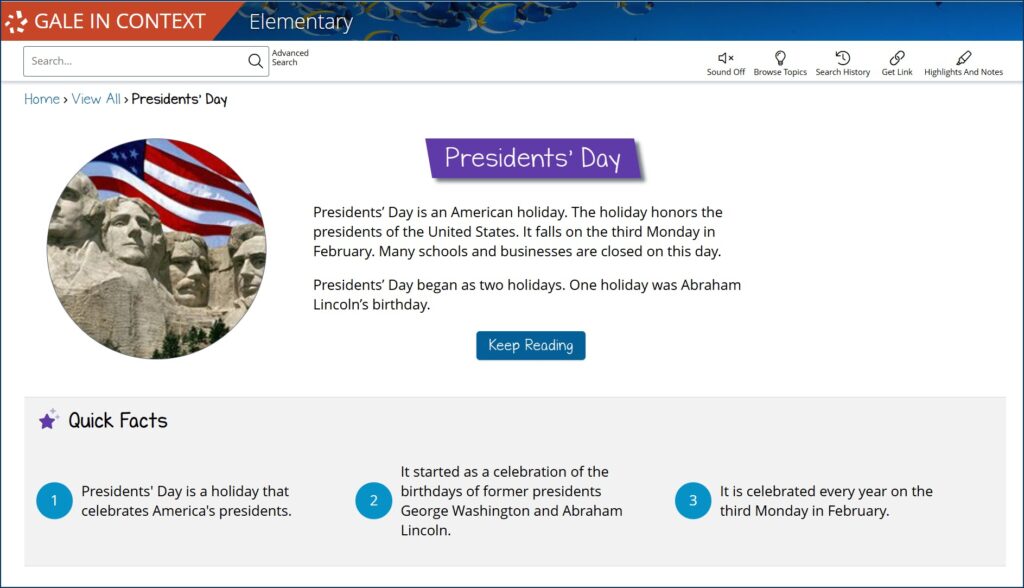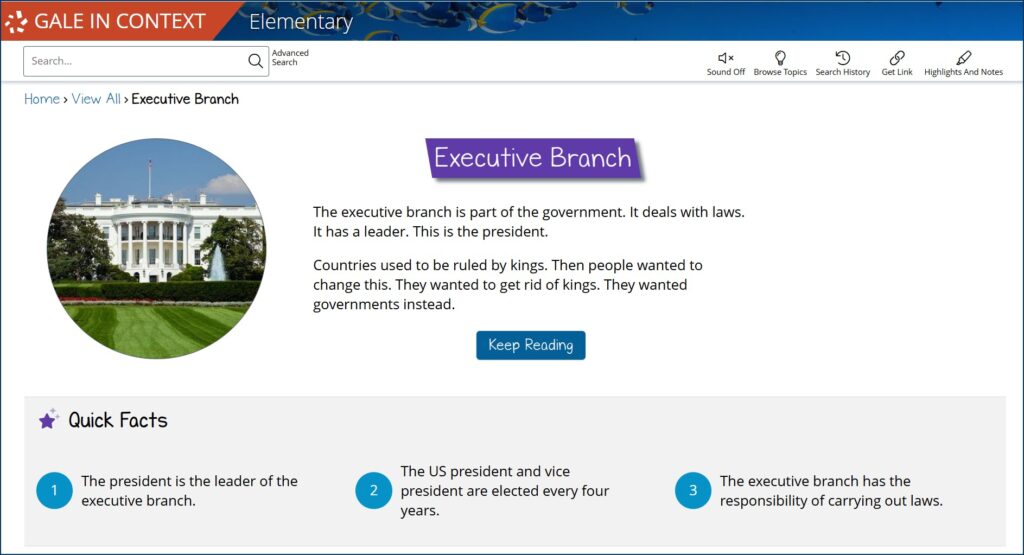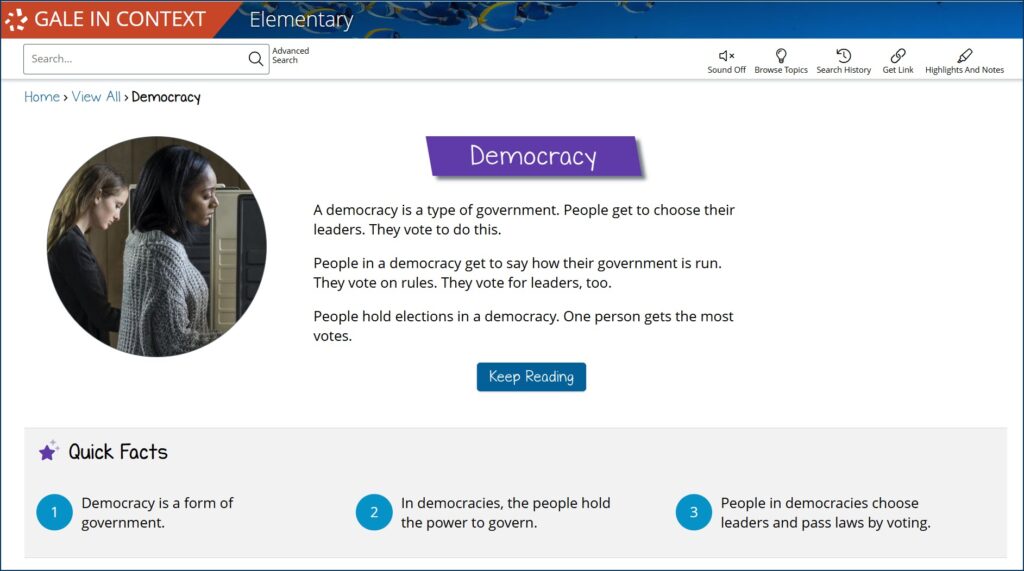| By Gale Staff |
Celebrated on the third Monday in February, Presidents’ Day was initially established as a national holiday in 1879 in observance of George Washington’s birthday. In the time since, the holiday has grown to recognize all U.S. presidents and their contributions to the nation.
Presidents’ Day is a perfect chance for elementary students to learn about the executive branch and the occupants of the Oval Office, past and present. Gale In Context: Elementary makes it easy for elementary learners and educators to find engaging, age-appropriate educational content. Topic pages organize resources for easy exploration, and search functions help students dive deeper into subjects that spark their curiosity while building their digital literacy skills.
As you prepare your lesson plans on the executive branch, explore the abundance of ready-made content available through the Presidents’ Day topic page on Gale In Context: Elementary.
The President’s Roles and Responsibilities
Let’s start with the basics. What exactly does it mean to be president? For elementary students, the job can seem almost mythical—after all, the chief executive is tasked with leading a nation of more than 300 million people. Yet, the president has clearly defined responsibilities, each outlined by the Constitution or dictated by historical precedent.
Chief Executive of the Federal Government
As chief executive, the president is responsible for maintaining a vast network of departments and agencies that enforce the laws Congress passes. The president appoints leaders to guide the work of these various agencies and keep them operating efficiently.
Commander in Chief of the Armed Forces
The Constitution grants the president the title of commander in chief of the armed forces, including the Air Force, Army, Coast Guard, Marine Corps, Navy, and Space Force. While the president holds ultimate authority, the day-to-day operations and strategic decisions are managed with input from appointed officials like the Secretary of Defense. This civilian oversight ensures the military reflects the will of the people and operates within the law.
U.S. Head of State
One of the president’s most important roles is acting as a unifying figure for the nation. From welcoming foreign dignitaries to the White House to delivering words of hope and comfort in times of tragedy to kicking off national celebrations, the president symbolizes the values and aspirations of the American people.
The Evolution of the Executive Branch
In 1787, the Constitution established the executive branch, led by the president of the United States, as one of the three branches of government. Unlike the monarchy Americans fought to overthrow during the Revolution, this new system balanced the presidency’s powers with the legislative and judicial branches to prevent any single leader from becoming too powerful.
As the nation grew, the executive branch adapted, with the formalization of rules further refining presidential powers to meet the demands of a changing country. Its evolving responsibilities require the nation’s leader to adapt to new challenges while working within our system of checks and balances.
The Cabinet
The Cabinet, a group of presidential advisors, has been part and parcel of the executive branch since George Washington’s first term. While Washington’s Cabinet comprised just four members—the secretaries of state, treasury, war, and the attorney general—it has grown to include 15 department heads. Despite its expansion, the Cabinet’s purpose has remained the same: to support the president in carrying out the responsibilities of the executive branch.
These department heads oversee a network of federal agencies—more than 2,000 in total—that enforce the laws passed by Congress. For example, the Department of Justice, led by the attorney general, includes agencies such as the FBI and the U.S. Marshals Service.
The president nominates Cabinet members and agency leaders, but the Senate must confirm them. This means that their appointments require the executive and legislative branches to agree that the person meets the nation’s standards of expertise and integrity.
Two-Term Limits
The tradition of the presidency being limited to two terms began with George Washington, who stepped down after serving eight years. His decision set a precedent that was followed by nearly all presidents for more than 150 years.
However, when Franklin D. Roosevelt was elected to an unprecedented four terms during the Great Depression and World War II, concerns arose about the potential for unchecked presidential power.
In response, Congress passed the 22nd Amendment in 1947, formally limiting presidents to two terms.
Inaugurations
The tradition of marking the official start of a new administration with an inauguration ceremony also began with Washington, who was sworn in on April 30, 1789. During this ceremony, Washington took the oath of office prescribed by the Constitution, as has each chief executive since.
Modern inaugurations see the president delivering an inaugural address, outlining their vision and priorities for their coming term to live crowds numbering in the hundreds of thousands—even surpassing a million, as was the case for Barack Obama’s historic inauguration in 2009.
Take a Virtual Field Trip to the Presidential Sites
Presidential monuments and museums serve as a living legacy of how each president rose to the challenge of leading the nation. They are concrete evidence of our collective progress as a country, showing how the executive branch has adapted to meet the changing needs and priorities of the public.
These virtual tours welcome your students to study how leaders are portrayed—through the architectural style, inscriptions, artifacts, or location—and what qualities we’ve deemed most admirable in those serving as the chief executive.
Thomas Jefferson Memorial
Opened in 1943, the Jefferson Memorial in Washington, D.C. honors the third president’s (1801–09) role in shaping American democracy. The memorial immortalizes Jefferson, the principal author of the Declaration of Independence, in bronze, surrounded by inscriptions of his writings to remind visitors of the core ideals of freedom and self-government that guided the nation’s founding.
The memorial’s neoclassical design—inspired by ancient Greek and Roman architecture—is symbolic in itself, representing Jefferson’s admiration for classical ideals of democracy and reason.
Although Jefferson lived in the late 18th century, many questions he posed about the balance between individual rights and collective responsibility continue today. While taking the 3D virtual tour with elementary learners, discuss principles like “life, liberty, and the pursuit of happiness,” and how they’ve been challenged or reinterpreted over time.
Theodore Roosevelt Island
This 88-acre island in the Potomac River serves as a memorial to Theodore Roosevelt’s conservation efforts. Theodore Roosevelt Island was opened in 1967, and it features walking trails and a central plaza with a statue of Roosevelt, surrounded by panels highlighting his speeches and our responsibility to protect natural resources.
During his presidency (1901–09), Roosevelt championed sweeping conservation policies to protect the nation’s wildlife and public lands. He set aside millions of acres for national forests and bird reserves and passed the Antiquities Act of 1906 to preserve sites of ecological and cultural importance, including the Grand Canyon and the Petrified Forest.
Take a virtual tour of the island. Roosevelt’s conservation efforts provide an excellent catalyst for discussing environmental stewardship, such as comparing historical conservation challenges with those of today. Students can also use Gale In Context: Elementary to research National Parks they’re curious to learn more about and discover why these sites are protected.
Jimmy Carter Presidential Library and Museum
Located in Atlanta, Georgia, the Jimmy Carter Presidential Library and Museum opened in 1986 to preserve the legacy of the 39th president (1977–81) of the United States. A virtual or in-person visit allows exploration of a wide range of exhibits, like a collection of artifacts related to the Camp David Accords. Carter brokered this historic political agreement that forged a groundbreaking peace treaty between Egypt and Israel.
Exhibits also detail Carter’s domestic policies, including his passing of the National Energy Act of 1978 to reduce U.S. dependence on foreign oil and his human rights initiatives that shaped both foreign and domestic agendas
The Jimmy Carter Presidential Library and Museum has a wealth of primary source material that gives learners tangible evidence of presidential responsibilities, nationally and globally. During the virtual tour, ask students to identify primary source materials that represent Carter’s role as commander in chief, chief executive, and U.S. head of state, and how the president’s various roles overlap and inform one another.
Make Learning Interactive and Engaging With Gale In Context: Elementary
With Gale In Context: Elementary in your classroom this Presidents’ Day, you have a platform designed to deliver differentiated instruction that keeps kids excited about learning.
Curious about the platform’s features? Ask your local sales representative for a trial and test out Gale’s wealth of educator-approved, standards-aligned articles, images, videos, and infographics backed by powerful tools like Lexile range filters.




